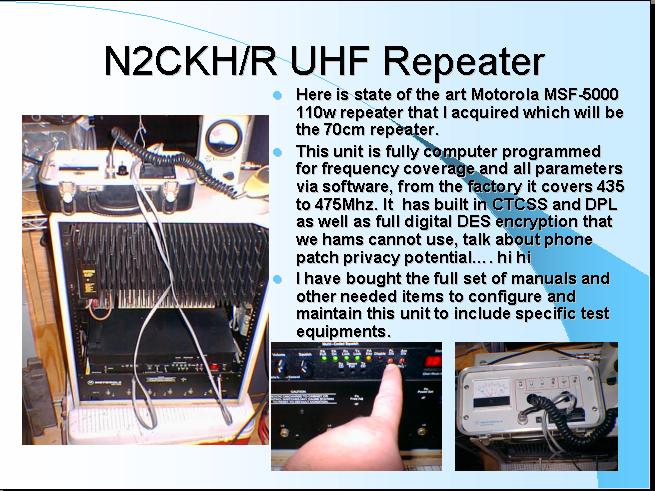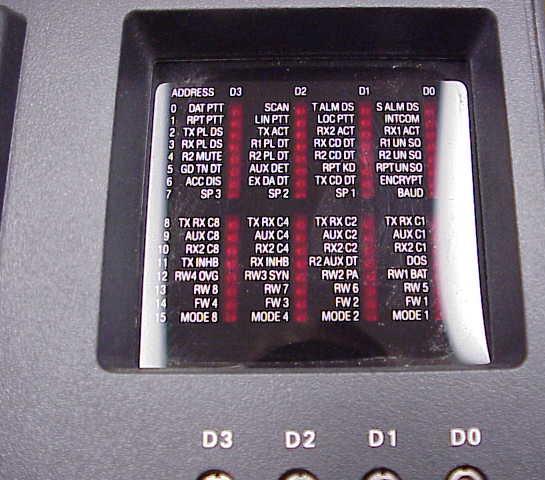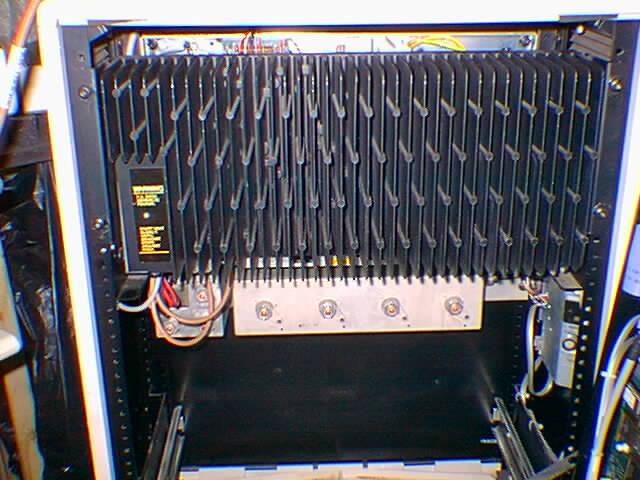
This system is currently based on a Motorola MSF-5000 Digital Station with a Celwave/RFS Station Master for an antenna.
UPDATE: It is now Spring 2003 and the planned repeater controllers for use on all the repeaters have not yet been released. As such IRLP node 4040 is moving from the 6m repeater to the 447.925 machine for a while to provide more access to IRLP from Lakewood with node 7280 sitting on 443.
For graphical screen captures of Terrain Analysis Modeling of estimated coverage area of the system click here.
To access the system use the primary PL tone of 141.3hz. This is the only tone that will normally be re-transmitted for use with CTCSS. The system can also be accessed with PL tones 127.3, 131.8, 136.5 and the DPL/DCS code of 031. The use of DCS/DPL is marginal at the moment as the station needs to be fully calibrated for that access method, it works but using my VX-7R the audio clips. For full DCS/DPL access with other like configured users you can use DCS code 315.
The previous system was a Motorola Mitrek based repeater (the same basic repeater previously used on 440.300 by Sam, WB2HAE except it was returned and crystalled to 447.925 and new controller) with an RC-96 controller interfacing to IRLP node 728 using a dbProducts duplexer. The Mitrek based system will be used at another location in the future as will the MSF-5000. The IRLP and other features will not be fully available on the MSF-5000 until more of its commercial characteristics can be changed and a third party controller can be integrated.

The MSF-5000 is a 1990's state of the art, fully software programmable and features an integrated compact pre-filter/circulator/post cavity filter and receiver cavity filter based tx/rx filtering instead of a more stnadard cavity duplexer. However, I may use it with an external duplexer to eliminate RF power and signal losses and other problems associated with this configuration.
I am fortunate that a Motorola test set I picked up cheap came with all cables for testing Micor, Mitrek and other radios planned for use and the MSF-5000 as well. I also have the MSF-5000 digital station test panel that provides local speaker and status display as well as test points.

The MSF-5000 PA in my station is capable of over 150 watts. Running at that level I have managed to get 90 watts out of the post filter with careful tuning. However, I have turned the output power down due the heavy duty cycle of IRLP.

I have added a three Rotron fan panel that my good friend Kal, KE2SO came up for me some time ago by simply installing two long srews from the inside of the cabinet secured to the maount rail and then drilling two holes in the fans and slipping it over and in front of the PA and holding it in place with some more nuts.

This particular A.C. fan panel is high speed and wisper quiet and is plugged directly into the internal station A.C. fused power outlet. This fan panel does of course negate the installationa of the locking front panel, which will be needed down the road when this repeater is used at another location.

Later the MSF-5000 will be replaced by a GE Master II UHF 100w continuous duty repeater that is waiting on channel elements for use with a DB Products duplexer. At that time the MSF-5000 will be reprogrammed and used on another frequency pair from another location where its compact size is needed.

A backup repeater will also be created from a GE Master II/M radio.
Please click here to send e-mail.
Entire contents Copyright © 1999-2001 by Stephen B. Hajducek, N2CKH. All Rights Reserved Worldwide.